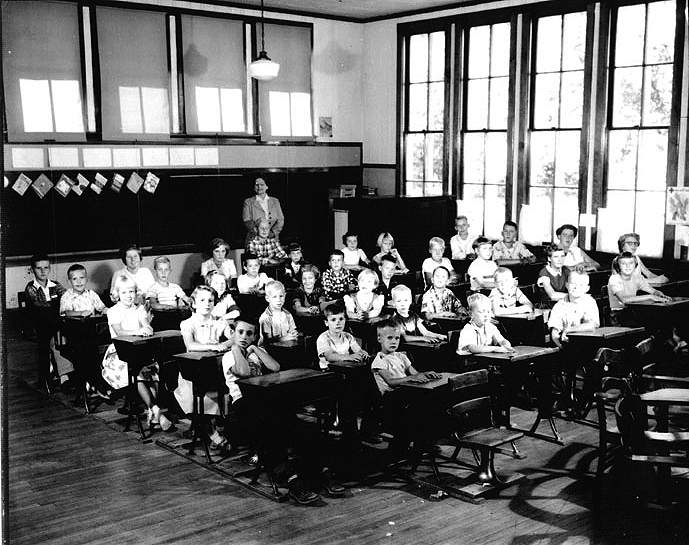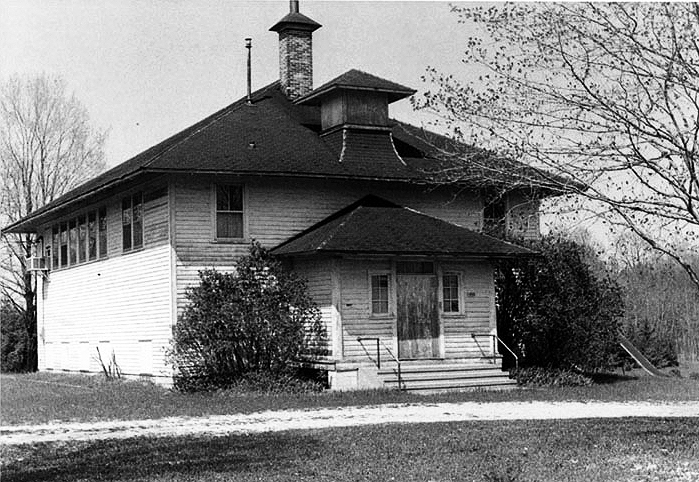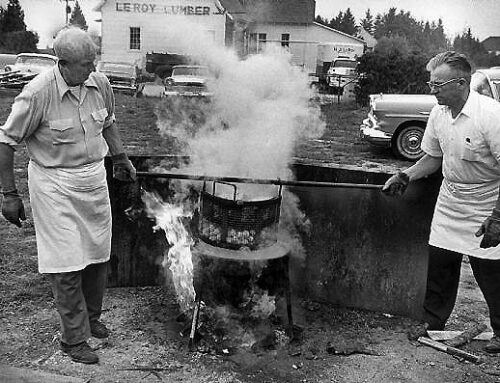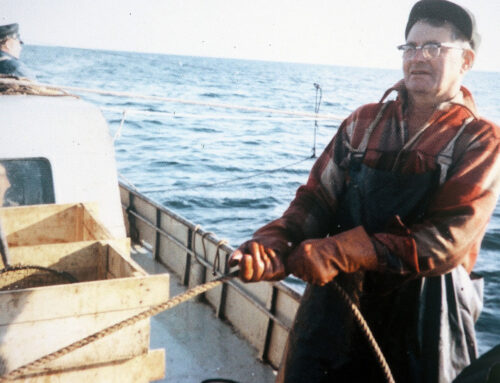By Richard Carter
Originally published in Door County Almanac #2, Dragonsbreath Press, June 1985
I stood at the foot of Appleport Road where it ends abruptly at the shore in a ridge of stones not quite right for skipping. In my hands was a century old map of Liberty Grove Township showing large capital letters APPLEPORT strung out from this point into the lake, like something important was once here. All I could see now was a model “T”-sized garage and a few big boulders just under Lake Michigan’s surface.
After a dozen years of kicking around the trails and shoreline, being curious about the suggestive name and seeing signs of another “civilization”, I decided to find out just what this place called “Appleport” was. I had rescued an abandoned cottage from ruin, chased out the bats and red squirrels and declared myself a resident of a quiet road named South Appleport Lane. Now I wanted to know who had lived here? What were their lives like? What was the history and links to the living present which I shared. Was it once a brisk little port shipping local apples to Chicago or Milwaukee for apple pies, apple cobblers, apple bobbing? Appleport, naturally.
Of course I knew a little about the fishing business that once operated right across the road from me. There remains the tumble of rocks and timbers known as “Larson’s dock”, now just a low ridge being reclaimed by Lake Michigan. And, the cottage next to it was remodeled from an old fish house just a couple of decades ago when the last of the commercial fishermen gave up. Then, there are the paths that zig zag like lightning strikes through the wild wetlands and go nowhere. Buffalo berry and red dogwood throw up their many arms to block any view of the scars and hold back trespassers from the old logging trails. I had heard stories about Appleport, the haunted village. A stranger I met at a Ridges Sanctuary meeting told me he had slides of all the old buildings which once clustered there. “A ghost town,” he said.
Hints and rumors. Nothing concrete, no records. Even the place itself is hard to find and there’s nothing distinct to define its borders. Some local folks know where it is, more or less. “Oh yeah, Appleport. It’s over east of Sister Bay along the Michigan shore.” That’s about it.
First, to find Appleport, the traveler should back all the way to Sister Bay and take a good running start across the peninsula. Driving east on County ZZ, the road dips and rises in gentle undulations noticeable only to the biker or jogger. Each ridge is crowned with large, old maples, the kind of tree line that, in the fall, makes me stop the car and reach for my camera. There are both new orchards and mature ones along the way, apple and cherry. No resorts. No condos. Just your basic interior Door County agriculture: orchards, pastures, a few black angus and some jersey cows. Apple trees march up the slopes in perfect military order. In the spring they look like the Continental Army all freshly wigged and awaiting Washington’s command.
Once over the last crest at Cisar’s Apple Barn, the land pitches downward toward Lake Michigan. The first hint of the place is a small green placard with white lettering proclaiming, “Grief Erickson, Founder of Appleport”. It’s an unlikely setting for a pioneer with its well-kept lawn and modern home well back from the road. Just Erickson’s little joke, but it’s followed immediately by three perfectly restored log cabins grouped as though it were a small settlement. Makes you wonder if this is “it”?
Well, it’s not.
Oh, the cabins are authentic enough, but they didn’t grow there. They were salvaged from abandonment and decay, hauled out of the woods from remote locations and restored. A provocative wooden plaque on one reads, “Accuse not nature. She hath done her part. Do thou but thine.” Milton. The cabins are at the intersection of Old Stage Road and County ZZ. Across the road to the east is a one room school house and a boarded up cheese factory. The 1960 edition of the U.S.Geologic Survey’s map of the area identifies “Appleport School” at the intersection, but the daisies stand tall in the yard, un-mowed, untrampled. The swings hang straight on rusty chains. It’s someone’s vacation home now.
Other symbols sprinkled along County ZZ on the old topographic map tell much of the physical story: orderly green dots for orchards; crossed picks and shovels for gravel pits; and blue tufts of grass for wet lands. Tiny black squares indicating homes are few and widely scattered.
From this point the rises and dips in the road are more subtle. The swales tend to be wet. Off on the right a pair of tire ruts in the gravel lead deep into the distance and disappear. At the end of the ruts is the site of one of the early settler’s homes, the Seaquist family. It’s in a swampy area known as Three Springs. These springs send damp green fingers poking into fields and through culverts under the road. This simple geography shows the marks of the last great influence on the land, the retreat of the glacier. It left its signature on the ridges where it paused and the swales in between.
There’s one last rise just as the highway starts its big bend to the north. County ZZ curves around a field of new cherry trees standing on skinny burgundy legs wrapped with white stockings. It’s like a bend of a river taking the main current away from the quiet backwaters.
If you’re not paying attention it would be easy to be carried right past the small road headed east, a tributary called Appleport Road. Navigation is uninvited by a “Dead End” sign. Just past Hazel Larson’s hand-painted mail box, a few grey ghosts of dead cherry trees can be seen. A line of shacks, the color of old bones, hide among the maples along the low ridge. Over the past couple of years they have been disappearing one by one. At the abandoned gravel quarry on the left, thick rows of Christmas trees hide deer. After that, there is no attempt at enterprise, just wild fields and woods. Old pasture land grows spotted knap weed whose lavender blooms swim with Monarch wings in the fall. A few surviving, but unattended, apple trees stand out among the fields as stragglers from another time. Sprigs of Juneberry blossoms break up the green on green of cedar, spruce and balsam fir in spring. Here and there a fresh gravel drive to a new vacation home interrupts a landscape left alone, returning home.
At last, the road snakes around a little “S” curve to reveal a sometimes blue, sometimes grey band stretching across the horizon; Lake Michigan in one mood or another. Next there’s a one room cabin with boarded up windows at a crossroad: South Appleport Lane and North Appleport Lane. On the southeast corner of the road stands a big 1920’s home on a stretch of grass the size of a football field leading all the way to the lake. Appleport Road runs right to the water’s edge, ends abruptly at the shore and looks out at the vast lake expectantly. We are back where we started, having glimpsed Appleport, but not quite seen it.
I look out there to see what the road sees. To the southeast is Marshall’s Point, the site of an Indian village. The Indians lived lightly on the land and left little mark except for their bones, some pot shards and a few arrow heads which still turn up. Out ahead is Spider Island, a thin shelf of rock and trees uninhabited except by herring gulls. Northeast is the curving shore of Newport State Park where the little logging town of Newport once thrived. It disappeared decades ago along with the timber. There are vague stories about the loggers who came to cut the cedar, the white pine, the red pine and the hemlock. They were gone in just a few years. Only a few stands of virgin timber can be found, salvaged by luck or unusual vision.
There were no descendants of the early loggers left behind that I could find to talk to and my neighbors are mostly like me, summer residents without history. So, I began with Hazel Larson, whose family I heard, had been around for a long time. We bought raspberries and beans her garden when we first camped out and started restoring our cabin in 1972. The land had been in her family for many years and I purchased it from her son, “Wink”. In asking about the history of the area, I was directed to her sister-in-law, Grace Landstrom. “She was born there, right down on the shore.” Hazel told me, “1904. She can answer your questions a lot better than me. I’ve only been here since ’33.”
When I met Grace at Hazel’s place she greeted me with a warm grandmotherly smile that seemed so at home on her smooth face. She sat with hands folded in her lap, her eyes often showing delight as she recalled experiences in response to my questions. Her dad had come to Appleport just about 1900 she told me. He was a fisherman just like his father before him. Started his own fishing business right down at the end of Appleport Road.
I asked about the big dock that was supposed to have been there. Someone said it went a quarter of a mile out into the lake. That mules hauled wagon loads of timber and cord wood out to be loaded onto sailing schooners bound for Milwaukee and Chicago.
Her dad had taken over a big timber and stone dock for his fishing business. Before that, she thought shallow draft vessels used it. Logs were also rafted out from there to larger ships waiting in deep water. In turn, sailing vessels had brought food and supplies to a general store located at the foot of the dock. The “store” was actually their 1860 vintage Victorian home.
“And what about the name ‘Appleport’? Did they once ship local apples out of that dock?”
“Oh no, that’s not where the name came from at all. My dad bought the store from two gentlemen. One was named Mr. Apple and the other Mr. Port.”
I felt the story was ending before it began. I had been so sure, but pressed on with my questions.
My wanderings along the edge of the boreal forest near the shore led me to old timbers and pieces of iron being stitched into the ground by twin flower. The remnants of a saw mill? Grace nodded. Her father did operate his own mill which he used to cut lumber for the twine shanties for his fishing business and the packing cases for his catch.
“What about the village of Appleport”, I asked her. “People told me there was a town there that had been abandoned, a haunted village. One man said he had pictures of it.”
Grace looked perplexed. “No, there was never any village. I would have known about that. There was just our place and one other family that fished, too.”
But what about all the buildings that were once there, the pictures, the kids who said they used to scare themselves coming over to the haunted village?” What they had seen was nothing more than the half dozen or so twine shanties and working buildings of the fishing operations of John Larson, abandoned after his death. They were the same small buildings that now line the dirt lane up at Hazel’s. They had been moved inland along the edge of the cherry orchard. They looked like forlorn migrants displaced from their homeland, some with old fishing sets still rotting on the floor. They belong clustered at some shore waiting for fishing boats to return, not gazing at a dead orchard. Years ago, a few were used to house other migrants, back when there was still a cherry orchard.
Hoping for some deeper history of settlement, I asked about the fallen remnants of a small shack back in the woods off the rough trail.
“Why that was just a hideout my brothers built when they were kids. They took a horse and hauled logs out of the forest. Put it all together themselves. Oh, it was real nice. Had a stove and some school desks. One night my dad went down there to look for them. They had taken the cream separated from the milk and the ice cream freezer. He found one of them making ice cream and the other was cooking candy by lantern light.”
“You know, we had no electricity, just lamps and gas lights. Later, after the fire, when my dad built the new house, he put in one of those plants that generated its own electricity. That’s what we had until the current came down, you know, the high volt.”
“What about school? Was the one at County ZZ and Old Stage the same one you attended?”
It was, except she also went to the old one before they tore it down to build a bigger school on the same site. Forty to fifty children were taught in the peak years.
“We were a bunch of kids for one teacher, but we learned just as much as they do now. We walked the two miles winter or summer. The only time my dad would come for us was in the winter if there was a storm. Then he would hitch up the horses and come with a sleigh. We had friends from the farms all around and there was a big stone along where the road to North Bay comes in; and we used to put our own stones on top of it so you could tell who had come by that morning on the way to school. Down where the stream from Three Springs came in there was a crook in the road and an old bridge. The boys would catch frogs and cook up the legs. Now the road’s been straightened out, the bridge is gone and the stream’s in a culvert.”
We went back to talk about her father’s fishing. Each morning the first sound she heard was that of the big Collumberg engine starting up and the chugging off into the darkness of predawn. The boats were called pond boats. They were wide of beam and open in contrast to the fully enclosed types which we usually see today. “There are just a few families still fishing around here now, very few,” she offered. “In those days, they didn’t use the gill nets, they used pond nets, like a big cage. They drove long poles with a pile driver into the bottom of the lake and hung the nets around them. You should have seen the fish they brought back each day. The boats were full right up to the gunnels, almost spilling over. It was herring mostly, but whitefish, too. The best seasons were spring and fall, summer wasn’t much.”
“The day’s catch was dressed flat along the back, salted and packed in wooden crates. We cut the wood from the forest at our own saw mill and made the crates ourselves. I nailed a lot of them together starting when I was eight or ten. The Dormer Fish Company would send its big boat down from Marinette and anchor off the shoals. Dad would have to go out in his boat to load the catch because it was too shallow for the big boat to come in.”
Grace only went out with her father in his boat a couple of times. In her own words she was “never much for the water”, even though she lived at its edge and they drew their living from it, she never learned to swim.
As intrigued as I was, Grace seemed to attach no special significance to her way of life. She just lived it, that’s all. A typical day to her was of little importance. Their days were filled with hard work, she would recall, “But, we had good times, I can tell you that.”
“In the morning, we had to get ourselves up and get ‘goin’, pack our lunches in a tin pail. We had a good time in school with spell’n bees on Fridays, our Christmas program and our big picnic the day school was out, all the games, ice cream, and lemonade, you know how that went. They don’t have that anymore. At night we had our work, get the wood, carry in the water and plenty of barn chores. I was eleven when my mother died and my oldest sister didn’t stay long, so I had lots to do. When my dad went on the lake in the morning, he’d call me to milk the cows. Then I’d make breakfast for them when they would come back. Once in a while, I’d wait in bed, but when I heard that old motor chugging, I got up! We had a strict dad, he was, but he kept us together.”
“Later, when I was in my twenties, we had the cherry orchard. I hauled plenty of cherries in our old Model “T” truck down to the dock in Sister Bay by Anchor Sam’s. After I was married, they built that plant up here at Old Stage and County ZZ across from Appleport School. That’s when you should been here to see all those trucks lined up for miles waiting to get in. The orchard business isn’t the same anymore. There’s no money in it so people gave up, just quit and let the orchards die.”
The orchards were first planted in the twenties, probably peaked in the forties and the Larson family finally abandoned their Appleport orchard in 1960. You can still see a few dead trees, last remnants of several thousand. There is still a Larson orchard in Ellison Bay, however.
Like his father before him, Grace’s dad fished all his life. When he died in 1952, her brother Everett took over and fished until 1966. The catches had declined and there just wasn’t a living to be made anymore. Her father’s death marked the end of an era and the beginning of another. John Larson’s lands were divided among the children and slowly they turned to other ways of earning a living.
Just as the wood cutters came and went in the late eighteen hundreds followed by the fishermen and farmers, now the land moved towards another wave of change.
The hemlock has been cut to extinction, the last herring netted, the cherry orchards abandoned, and the pastures turned to weed and the gravel quarried from the land. The old dock is being reclaimed by November storms, the fish shanties rot in woods, the clapboard peels on the boarded cheese factory, the school has been sold for a vacation home and the cherry plant houses a few pleasure boats for the winter. All that remains is the land. Now that final resource is being sold as the last generation of pioneers takes its due before passing from the scene. The land has been divided and sold and divided again for homes with a view of the lake or a piece of wild roadside. Summer residents who now settle the land bring a love for Door County and a desire to be part of it, but they bring no sense of history nor will they leave any.
The Scandinavian names will be replaced by the polyglot of midwestern heritage. Our children won’t attend school together and we won’t be trying to win a living from the land nor the lake. Hopefully, we will remember why we came to this place, respect it, will not hastily recreate the city and suburban environment we just left behind.
I like to stand at the shore in the early morning and watch for the few remaining fishing boats to chug out of Sand Bay as they have for decades. There is something about being witness to this tradition that moves me. And, it troubles me to know their sound will be replaced by that of my neighbors’ power mowers.








Social Contact